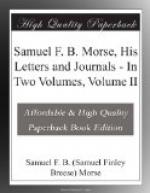It is only necessary to remember that the year 1840, and the years immediately preceding and following it, were seasons of great financial depression, and that in 1840 the political unrest, which always precedes a presidential election, was greatly intensified, to realize why but little encouragement was given to an enterprise so fantastic as that of an electric telegraph. Capitalists were disinclined to embark on new and untried ventures, and the members of Congress were too much absorbed in the political game to give heed to the pleadings of a mad inventor. The election of Harrison, followed by his untimely death only a month after his inauguration and the elevation of Tyler to the Presidency, prolonged the period of political uncertainty, so that Morse and his telegraph received but scant attention on Capitol Hill.
However, the year 1840 marked some progress, for on the 20th of June the first patent was issued to Morse. It may be remembered that, while his caveat and petition were filed in 1837, he had requested that action on them be deferred until after his return from Europe. He had also during the year been gradually perfecting his invention as time and means permitted.
It was during the year 1840, too, that Messrs. Wheatstone and Cooke proposed to join forces with the Morse patentees in America, but this proposition was rejected, although Morse seems to have been almost tempted, for in a letter to Smith he says:—
“I send you copies of two letters just received from England. What shall I say in answer? Can we make any arrangements with them? Need we do it? Does not our patent secure us against foreign interference, or are we to be defeated, not only in England but in our own country, by the subsequent inventions of Wheatstone?
“I feel my hands tied; I know not what to say. Do advise immediately so that I can send by the British Queen, which sails on the first prox.”
Fortunately Smith advised against a combination, and the matter was dropped.
It will not be necessary to dwell at length on the events of the year 1841. The situation and aims of the inventor are best summed up in a beautiful and characteristic letter, written on February 14 of that year, to his cousin, the Reverend Edward S. Salisbury:—
“Your letter containing a draft for three hundred dollars I have received, for which accept my sincere thanks. I have hesitated about receiving it because I had begun to despair of ever being able to touch the pencil again. The blow I received from Congress, when the decision was made concerning the pictures for the Rotunda, has seriously and vitally affected my enthusiasm in my art. When that event was announced to me I was tempted to yield up all in despair, but I roused myself to resist the temptation, and, determining still to fix my mind upon the work, cast about for the means of accomplishing it in such ways as my Heavenly Father should make plain. My telegraphic enterprise




